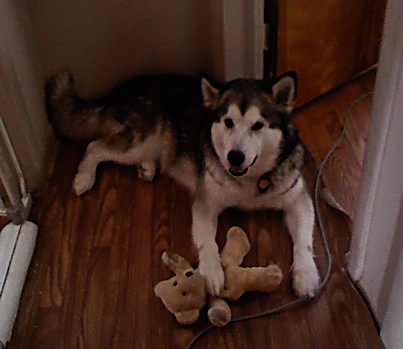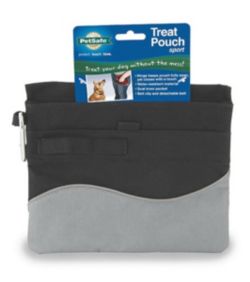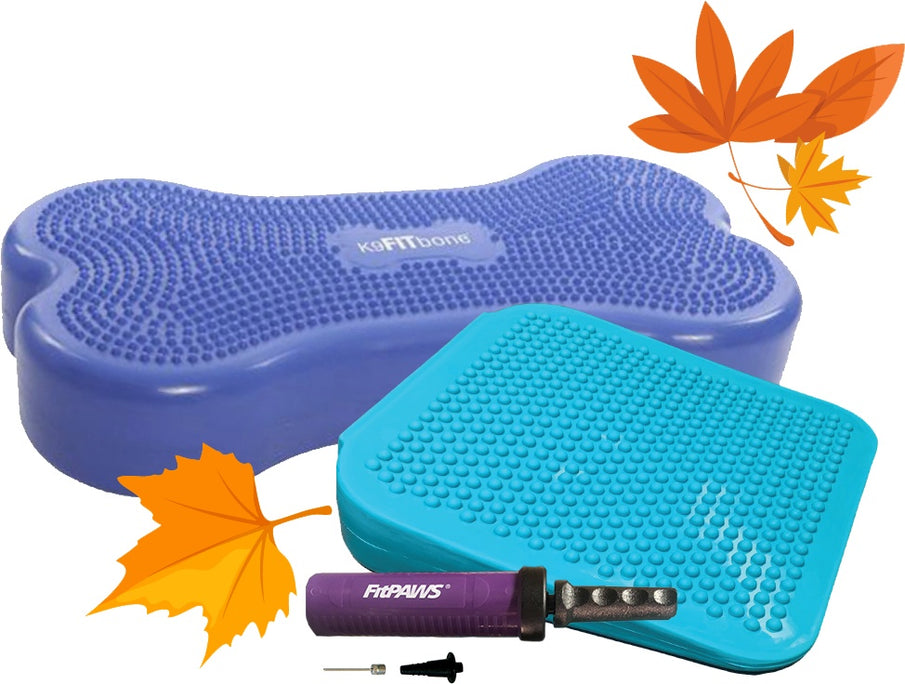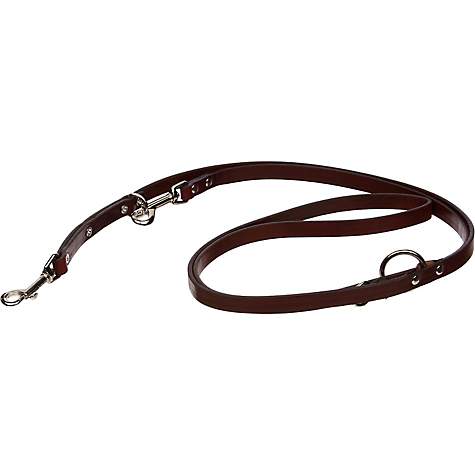Oops I Did it Again...
Training and Motivation -
what works and what doesn't 
Training and Motivation
If you fail to train your Malamute actively, it is PERMISSION to do as he pleases. You’ll need a good book on basic training and to attend a puppy kindergarten class or beginning obedience with your puppy. "Sending the dog out to be trained" without the owner involved is a waste. Find a class that uses POSITIVE REINFORCEMENT METHODS (what is that? usually they use praise, treats, play as a reward rather than punishment). If the trainer feels overly negative about Malamutes – run! Many trainers are knowledgeable about how to train Labs, Goldens, Shepherds etc. but are totally ignorant about how to motivate a Malamute. Malamutes are very intelligent. A lot of jerking on the collar just doesn’t impress them. In fact, it’s apt to make them decide you’re stupid. You need to talk to them a lot, work out your relationship. Let them know you’re the head of the pack. Training collars and halters are useful only in that they’re just signals. To a Malamute they’re not punishment or a correction. They are just a reminder. So are treats. Don’t be overly dependent on food training however, as it tends to sidestep the issue of "alpha" and food rewards will steal the dog’s attention rather than allowing it to be captured by the excitement of learning. A Malamute understands that the sits, the downs, are all a game. You can’t "obedience train" a Malamute because they don’t really "obey". They’re a dog that, when pulling a sled, will override you if you make a dumb decision.
In obedience, they do what you want because they like you and want to please you, but it isn’t obedience. It’s cooperation. So they just don’t train the same as other breeds. The challenge is motivation. You must inspire them to want to do things for you; punitive punishment or force almost never works. Trainers that use shake cans and water spray bottles for training are likely to be disappointed. A Malamute is often unimpressed by these silly training methods, and ours think the spray bottle is a terrific playtime activity! Repetitive drills bore them. Unless you plan to do serious competitive obedience work, it can be frustrating to expect perfect sits (Mals are notoriously sloppy sitters!), precision heeling, or instant mindless response. Dogs don’t learn from lectures (they use the "off" button), since to them it sounds like "bla bla bla bla bla bla". And you can’t "shame" a dog into doing right (such as rubbing his nose in a potty accident). It doesn’t work because shame is connected to conscience, and dogs don’t really have one (at least not a PRIMATE conscience). Dogs look at things differently than we do, everything is either "alpha is happy" or "alpha is upset". When you return home to a chewed sofa, or poop on the carpet, what we think of as guilt (ears back, rolling on his back) is merely the dog sensing your anger and showing submission. It’s the "dog way" of making everything right again. All he knows is he doesn’t want you mad at him, and has no idea what made you angry. If you punish him at this point, he’ll think you’re crazy, inconsistent and not worth listening to. After all, he was doing what dogs are supposed to do – submitting to make you (alpha) happy! You obviously don’t know what you’re doing (from his point of view) and don’t deserve his respect or obedience.
What motivates a Malamute? Respect for and praise from a worthy owner most of all, then food, comfort, social attention, possibly fun and games. Malamutes need to begin training as soon as they begin moving around as small pups and begin interacting with littermates. You need to begin working on the simple basics as soon as you bring him home. Puppy/obedience classes should be taken when he’s 3 to 4 months old (not 6 like most breeds). Malamutes that acquire a bad habit or behavior as puppies are almost impossible to break of it. It’s better to lead and show him what you expect right away than let his behavior get out of hand and expect to "take obedience" and "fix" it later. If you fear being "dominant" over your Mal because you fear you will lose his love, you are WRONG! There is nothing more attractive and adored as the one recognized as worthy of leadership to a Malamute – his Alpha. From this hierarchy he draws his security and worth.
The areas you will have to work on most with your Malamute puppy are stealing food, getting in the garbage, comes, crotch sniffing or jumping on guests, digging outside and for the tidbit that falls under the sofa, occasional grumbling, aggression toward other dogs and food guarding. These will be on going areas of training, needing remedial work throughout the dog’s life. Education should never end, for you or your dog.
The most important thing is to remember YOU are the ALPHA – the pack leader, the BOSS, the one that makes the one that makes up the rules. Alphas arbitrarily do things to reinforce their dominance over pack members (your puppy). Your voice and gestures are very important. Praise should be high-pitched and happy, a correction should sound deep and angry. Women are usually great praisers but have trouble getting the dog to listen to a correction because it’s not said deep and firm enough. Men have deeper voices when it comes to a "no" but often don’t praise enough for good behavior. Think about it – until your puppy learns what the words mean the only way he is sure something is good or bad is the tone of your voice. So make the goods and bads distinctly different. As Alpha you must also enforce what you ask. If you tell him come and he doesn’t, go get him. If you tell him sit and he doesn’t, guide him into position. If you don’t want to be bothered following up – DON’T ASK. If he feels you won’t enforce your requests, he will begin to stop listening and do what he wants and lose a little respect for you along the way. Teach your pup to "SHAKE HANDS", "DOWN" and "STAY" all submissive gestures. Using these things at your whim or if the puppy is getting growly, aggressive or over-excited in play and you are painlessly reinforcing your status as boss. Do these exercises several times a day, more often to a young puppy or one entering adolescence (about 6-10 months old) and you will have fewer problems. Let children teach the puppy a trick. This will reinforce the child’s dominance over the puppy. Always supervise though. Also, a bad habit to get into is letting the dog sleep on your bed. (Sleeping in the bedroom is OK). Sharing the bed says he’s an equal, which some Mals take to mean he’s superior – the start of behavior problems. You can invite him up occasionally and tell him to leave with "OFF", but it’s a bad idea to let him EXPECT to sleep there whenever he wants.Another bad habit is letting him "grab" you by the arm. That is another dominant gesture as is knocking down children. Riding the leg of a visitor or family member is not sexual play, but dominance. A dog that is "humored" about this may become a serious problem as an adult because he has just told you he thinks he is YOUR boss.
Food Guarding and Testing Authority
As your puppy becomes older he may begin to test your "alphaness". Some puppies never or rarely test. If you have children he may test them as well, since he will think of them as littermates. If may begin with a low grumbly-growl when eating or guarding a rawhide or toy. Any member of the family should be able to take away toys or look in his mouth for foreign objects. (You can open the dog’s mouth by holding the muzzle and pressing the cheeks into the teeth, then pull down on the lower jaw to open). If you take a chewy, food or toy away and he doesn’t complain, praise him generously, give it back, then LEAVE HIM ALONE to enjoy it. If he should growl, reprimand him (either verbally or a scruff shake if necessary), then LEAVE HIM ALONE. Don’t keep taking it away to "test" his reaction. Doing so will undermine his trust in you and he will guard more than ever. Corrected immediately and consistently, it won’t progress to out-and-out growls and the dog biting to protect his food or toy. Another trick is to add something especially yummy to his food dish occasionally while he’s eating and praise him for letting you add it without grumbles (correct him if he does). He needs to know ALL members of the family are above him in the pack, not equals. Let older kids correct too (under supervision). Mals will outgrow guarding behavior if corrected consistently and well, but grumbly behavior sometimes reappears intermittently in adolescence (6-10 months) and with some pups again at 1 or 2 years. At this age some pups will go through a stage of getting into "trouble", seeming to forget everything they’ve learned so far. A dog that was previously an angel in the house becomes a brat. Chewing, digging, getting in the garbage, escaping from the yard, anything is possible. Congratulations, you have a teenager! Try to anticipate (you know when he gets that sneaky look) and be ready with a loud NO GARBAGE (or NO DIG, etc.). Teens can be very stubborn. ALWAYS USE THE SOFTEST CORRECTION THAT WORKS! (Unless it’s a serious offense – he stole the expensive roast from right in front of you – then you’ll want to make a big impression IMMEDIATELY - but you should NEVER hit a Malamute such as with a rolled up newspaper, kicking, or other abuse - he will never respect you if you do and may ignore you completely next time).
"Pinning" or the Alpha Roll Technique
This technique has been very "overrated" with some as the solution to everything. Used in conjunction with other good corrections it works well, but it’s only one tool and should not be used often. This is used for an over-excited, hyper puppy. Use for a pushy and dominant adolescent testing you, perhaps trying to "hold" your arm or refusing to cooperate when you are grooming. This is not a correction for a dog that actively steals your sandwich or potted plant in the house. To do it properly there should be just firm pressure – no pounding, no aggression on your part. Hold the puppy (or young adult) still with one hand on the neck and the other on the back thigh with the puppy on his side. Hold him firmly until he relaxes. If he struggles, just maintain your hold and be patient. This is NOT to be a battle of wills and you cannot lose your temper because if it becomes that, the dog will always win. If it is an adolescent, you may have to gently SIT on him (of course you don’t put your entire weight on him, but sometimes it helps to position your body over the dog). You must be firm, in control, and calm. You’ll know true "submission" because a back leg will be straight. Some pups are good at "faking it" and will LOOK like they’re submitting by lying still and pretending to relax, but if you should usually watch the leg and wait for it to straighten before you let the pup up.
Problem Solving using Positive Reinforcement
With all the above correcting, you're probably wondering "what is positive reinforcement"? It means you reward behavior you desire, and ignore or shun behavior you dislike. Positive reinforcement for dogs is a treat, a happy voiced "good dog", some attention and a few pats. It can be a hug, a head rub, playtime - anything your dog finds particularly pleasant and "rewarding". Negative reinforcement is a gruff voice "BAD DOG", isolation from the pack (which are OK to use), but also includes hitting, kicking, screaming, beating and others (which are NOT OK). Again, you should never hit a Mal, he will only resent you, often the behavior will worsen. He may even bite at you because he feels your way of correcting is "unfair" from a dog point of view. (Dogs don’t hit each other to discipline - that is a primate activity). You must be a teacher and correct as his mom would. If corrections are done with conviction and consistency the puppy will learn. PRAISE for any behavior you want repeated, even if you forced him to do it against his will! And, be confident. If you’re not sure what you want, he won’t be sure what you want either. Play with your puppy. Praise his beauty, his behavior, his good manners. Through play he will learn allot about what you want him to be by the way you play whether it is gentle and quiet, or rough and rowdy.
Timing is most important. The reinforcement (positive OR negative) MUST be used while the dog is DOING the behavior – it is useless an instant before or after. You can "shape" your dog’s behavior entirely without punishment. Dogs really don’t understand punishment. The difference being – a "correction" is deliberate, done at the moment of the misdeed and is not meant to hurt, but to teach. "Punishment" is done after the fact, out of anger or to "get even" and make the dog "pay". The purpose is to cause pain and remorse. Punishment is NOT acceptable for training a Malamute. Malamutes are big risk takers and if they feel you are being unfair may snarl, snap or growl out of frustration. A few will cower, submit or refuse to do ANYTHING (why they’re said to be "stubborn"). You’ll never get remorse. The natural reaction is to get angrier because the dog "still won’t do what I want" and punish more, and before you know it you have a "mean dog" that doesn’t respect you enough to listen at all. A better way is to reward behavior you want.
One method is extinction. If you don’t like the behavior, ignore it – often difficult to do. Don’t reward a behavior you don’t like by acknowledging it in ANY way and it will EVENTUALLY go away. This method takes patience and isn’t appropriate for some situations. It works well for begging. If you CONSISTENTLY don’t reward by giving a treat EVER, he eventually won’t bother to beg. A great example is I love red licorice. I will give the dogs bits of potato chips, popcorn, and other treats, but for some reason, I never shared my licorice. Suddenly one day I realized, none of them EVER mooch for licorice (it's not that they don't like it either - Nova loved licorice). I could get other treats out and would be surrounded by dogs, but if I had a stick of licorice, nobody even bothered to get up! The key is consistency, give that treat just once and he’ll always wonder if THIS time you will too.
Another method is put the behavior "on cue". This means teaching a word for whatever the dog is doing that bothers you. Once he knows what the word means, you can tell him not to do it. Dogs are often taught "speak", then told "enough" to quiet them when they go overboard. We have worked on this with Shadow for his loud, insistent barking. He was taught him to "wisper" this way - so at least now, (sometimes) when he barks, it is much less irritating. This works will for overzealous kissers too. Let someone that enjoys them give it a name, "Good Kisses, Rover!", then, when you don’t want them, tell him "NO Kisses!" He’ll realize it’s the kisses you’re rejecting as you push him away, not him. Have anyone that doesn’t want the kisses correct him this way. Soon he’ll learn who likes them, who’d rather not, and when a face is clean enough!
Teaching an incompatible behavior is another method of positive reinforcement. An example is teaching the dog to sit whenever it greets people. He can’t jump up on people and sit at the same time. This is accomplished by asking the dog to sit (or putting it in a sitting position) EVERY TIME you greet the dog and give it a "hello" pat. Consistency is very important when using positive reinforcement. Praise if the dog just happens to come up to you and sit on his own. No, it may not happen often, but use those opportunities when it does! Eventually he will make the connection and be sitting nicely waiting for your attention – when he does – give it to him! You may enlist visitors to help. Have the dog sit before anyone touches it (guide the dog to a sitting position if necessary). If you must set up some "greeting" situations for practice, that’s OK. Another example is to teach the dog to lie quietly in another part of the room while the family is eating. It can’t beg at the table if it is on the other side of the room. One of our pups was taught this, and now has the best manners when company comes over! This will interrupt a few dinners while you get up and put the dog back into position and return to eating, but after a few times he will get the idea and you will only have to correct intermittently after that. How much better to train the dog to behave while you are eating rather than locking him in another room where he learns nothing and just gets frustrated for being isolated from his pack without knowing why.
Changing the motivation works as well with dogs as it does with children. It is vitally important to understand with Malamutes because you need to know their motivations are driven by survival and their sled dog heritage. He is not motivated by your love and good will, but what he wants – NOW. He didn’t kill the squirrel out of anger, spite, fun or anything else – it is his inborn need to hunt. If you don’t want him killing critters, your best bet is to keep them out of your yard. (So WHY did you get a Mal knowing they do this?). If your Malamute has a puzzling behavior problem, think hard about possible motivations. Could he be tired or ill (grouchy), bored or stressed (chewing), hyper (not enough exercise or bored), lonely (howling), fearful (snapping and snarling)? If it is possible to eliminate the underlying cause, the behavior will usually go away.
Shaping behavior works well for most situations you need to change. This is what most dog training is all about. You begin by giving a treat and say "good boy" EVERY time the dog does APPROXIMATELY what you want. As he gets more reliable you only give the treat and "good boy" for a slightly better sit, slightly faster down. (Do not try and correct too many behaviors at once. Concentrate your efforts on one or two things at a time and you will be more successful.) Eventually you sometimes "forget" the treat and just give a happy "good dog". What is happening is the words "good dog" are becoming their own reward. The treat is no longer the most important motivator – getting the praise is. This is shaping the dog to respond to your praise only. No punishment is involved if the dog doesn’t do what you want. If he doesn’t come, go get him and lead him into the house (then give praise and a treat for coming – even if it wasn’t his idea now, eventually it WILL be). If he doesn’t sit, gently push him into position (pull up on the collar while pushing down on the hips). Don’t’ forget the praise and treat even if he didn’t do it on his own at first. Eventually you can begin rewarding ONLY when he does it on his own, but not at first. A personal example is Shadow started challenging us about going in his crate one day - he would get nasty and growl, using very dangerous threatening behavior. Rather than confront him and make it a battle of wills (dangerous to us), we rewarded him with a small treat whenever he went in his crate willingly. After awhile it worked TOO good - he was trying to go to bed (he sleeps in his crate) at 7:00 pm just for the cookie! So that is good reason to eventually taper off giving the treats for every instance once the dog is reliably doing what you want. The point is, it works!
Negative reinforcement should ONLY be used in conjunction with positive reinforcement. Some negative reinforcement is OK to do – a "NO", a gruff voice, FIRMLY pushing or guiding the dog into the position you desire – it helps the dog understand what you want without waiting for him to do it accidentally. If you use more severe negative reinforcement be sure the offense warrants it or you will lose your dog’s respect and obedience the rest of the time. If you are not a fair, firm and consistent alpha, negative reinforcement will probably have no effect on your Malamute. He’ll just ignore you. Negative reinforcement is best used only for those offenses that are dangerous or very irritating. Food stealing, digging, puppy bites, aggressiveness. (A gentle but highly effective negative reinforcement mama dog uses is to hold the puppy’s mouth shut – you can add a stern "NO".) Always try to think of a positive reinforcer FIRST. When owners rely too heavily on very negative reinforcements (pinch collars, hitting, rolled newspapers) it sets you up for frustration, and it may start the roll downhill to stubborn or even aggressive behavior. This is not to say you should not discipline or train your dog to the behavior you want, but don’t lash out in anger (and a Malamute can be expert at making you angry and trying your patience!). Consider how they train dolphins and other highly intelligent sea mammals…They don’t use pinch collars, hitting or other severe methods – they would just swim away. It’s ALL done with positive reinforcement. It works for people too. Gentle by FIRM direction is all your dog needs to become a well-behaved companion and friend.
The bottom line...COMMON SENSE and "DOG SENSE"
Some people are born with one or the other or both! If you have neither, you shouldn't own a dog! Sometimes the best solution to a dog problem is common sense. If you don’t want the dog in the garbage, don’t leave it out. If you don’t want him to run away, fence the yard. If you don’t want accidents in the house, don’t leave him alone for long periods where he must "hold it" and can’t ask to go out. If you don’t want him to enjoy ripping open YOUR packages, don’t give him wrapped gifts to open. If you don’t want him chewing YOUR shoes, don’t give him shoes to chew – he may not notice the difference. You still can and should correct, but isn’t it sometimes easier to eliminate or never establish the reason for the problem?
Note: Each dog is an individual, and what works for one may not work for another, these are general guidelines. If you have any doubts about how to handle a situation, or have ANY safety concerns, consult a professional trainer.
More information & Helpful links...
Some good Positive Training Articles
















